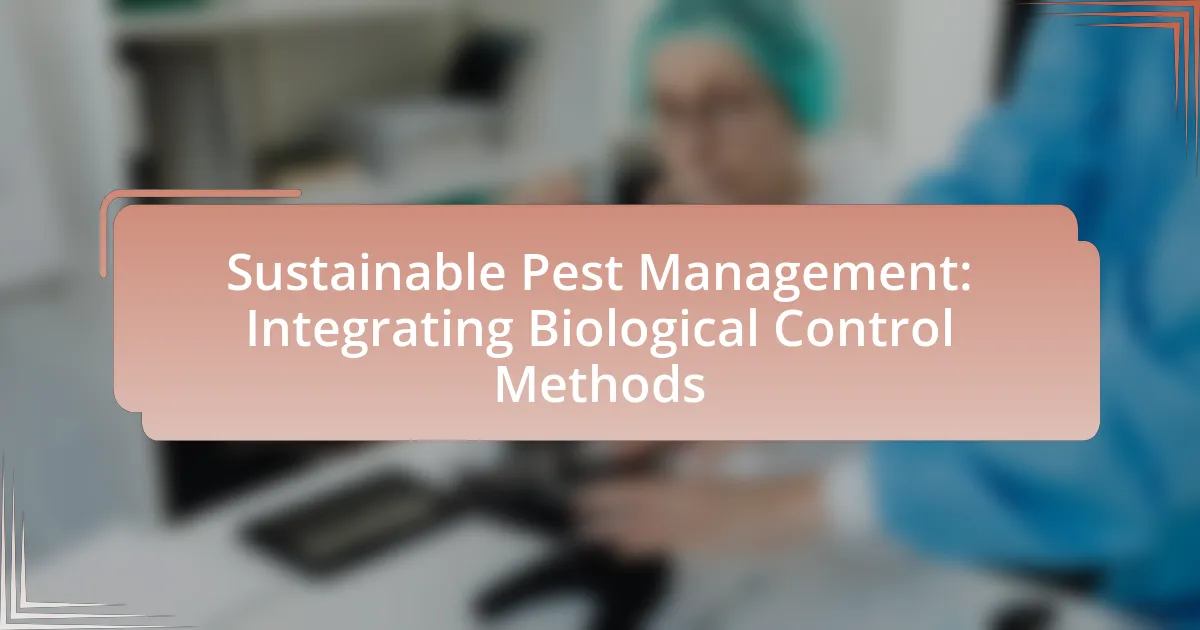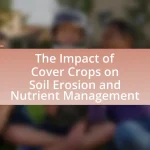Sustainable Pest Management (SPM) is an ecological approach aimed at controlling pest populations while minimizing environmental impact and promoting long-term agricultural productivity. This article outlines the principles of SPM, highlighting its differences from traditional pest management methods, which often rely heavily on chemical pesticides. Key strategies discussed include biological control, habitat manipulation, and cultural practices, all of which contribute to healthier ecosystems and improved crop yields. The article also examines the role of biological control agents, their economic advantages, and the challenges associated with their integration into pest management practices, emphasizing the importance of ongoing education and collaboration for successful implementation.
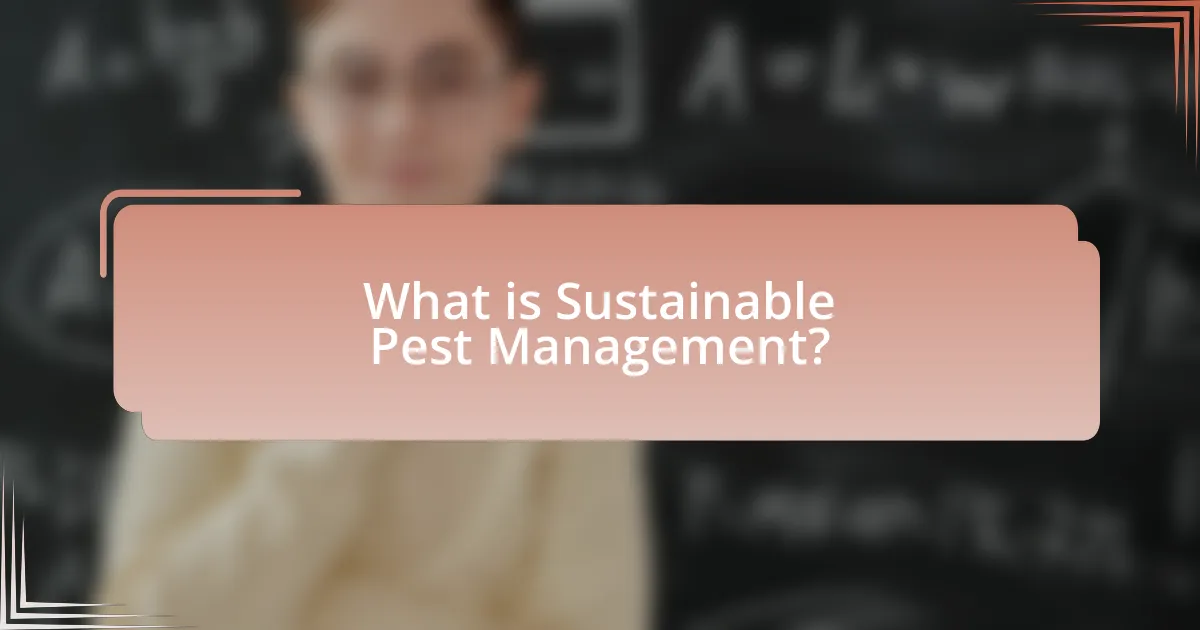
What is Sustainable Pest Management?
Sustainable Pest Management is an ecological approach to controlling pest populations that minimizes environmental impact while promoting long-term agricultural productivity. This method integrates various strategies, including biological control, habitat manipulation, and cultural practices, to manage pests in a way that reduces reliance on chemical pesticides. Research indicates that sustainable practices can lead to healthier ecosystems and improved crop yields, as evidenced by studies showing that integrated pest management (IPM) can reduce pesticide use by up to 50% while maintaining pest control effectiveness.
How does Sustainable Pest Management differ from traditional methods?
Sustainable Pest Management (SPM) differs from traditional methods primarily by emphasizing ecological balance and the use of natural pest control mechanisms rather than relying solely on chemical pesticides. SPM incorporates practices such as biological control, habitat manipulation, and the use of resistant plant varieties, which aim to reduce pest populations while minimizing environmental impact. In contrast, traditional pest management often focuses on the application of synthetic chemicals to eliminate pests quickly, which can lead to negative consequences such as pesticide resistance, harm to non-target species, and environmental degradation. Research indicates that SPM can enhance biodiversity and promote long-term agricultural sustainability, as evidenced by studies showing that integrated pest management strategies can reduce pesticide use by up to 50% while maintaining crop yields.
What are the key principles of Sustainable Pest Management?
The key principles of Sustainable Pest Management include prevention, monitoring, and control strategies that minimize environmental impact while effectively managing pest populations. Prevention focuses on practices such as crop rotation, habitat manipulation, and the use of resistant plant varieties to reduce pest establishment. Monitoring involves regular observation and assessment of pest populations to make informed management decisions. Control strategies integrate biological control methods, such as the introduction of natural predators or parasites, alongside cultural, mechanical, and chemical methods, ensuring that interventions are environmentally sound and economically viable. These principles are supported by research indicating that sustainable practices can lead to long-term pest management success while preserving ecosystem health.
Why is Sustainable Pest Management important for agriculture?
Sustainable Pest Management is important for agriculture because it enhances crop productivity while minimizing environmental impact. This approach reduces reliance on chemical pesticides, which can lead to soil and water contamination, and promotes biodiversity by utilizing natural pest control methods. Research indicates that sustainable practices can increase yields by up to 20% while decreasing pest-related losses, demonstrating their effectiveness in maintaining agricultural sustainability and ecosystem health.
What role does biological control play in Sustainable Pest Management?
Biological control plays a crucial role in Sustainable Pest Management by utilizing natural predators, parasites, or pathogens to manage pest populations. This method reduces reliance on chemical pesticides, thereby minimizing environmental impact and promoting biodiversity. For instance, the introduction of ladybugs to control aphid populations exemplifies effective biological control, leading to healthier ecosystems and sustainable agricultural practices. Studies have shown that biological control can significantly lower pest numbers while enhancing crop yields, demonstrating its effectiveness and importance in sustainable agriculture.
What are the different types of biological control agents?
Biological control agents are organisms used to control pest populations through natural mechanisms. The main types of biological control agents include predators, parasitoids, pathogens, and competitors. Predators, such as ladybugs, consume pests directly, while parasitoids, like certain wasps, lay eggs inside or on the host pest, leading to its eventual death. Pathogens, including bacteria, fungi, and viruses, infect and kill pests, while competitors, such as certain plants or insects, outcompete pests for resources, thereby reducing their populations. These agents are integral to sustainable pest management strategies, as they provide environmentally friendly alternatives to chemical pesticides.
How do biological control methods contribute to pest population regulation?
Biological control methods contribute to pest population regulation by utilizing natural predators, parasites, or pathogens to manage pest species. These methods effectively reduce pest numbers through predation, parasitism, or disease, which can lead to a more balanced ecosystem. For instance, the introduction of ladybugs to control aphid populations demonstrates how a natural predator can significantly decrease pest numbers without the need for chemical pesticides. Studies have shown that biological control can reduce pest populations by up to 80%, highlighting its effectiveness in sustainable pest management practices.
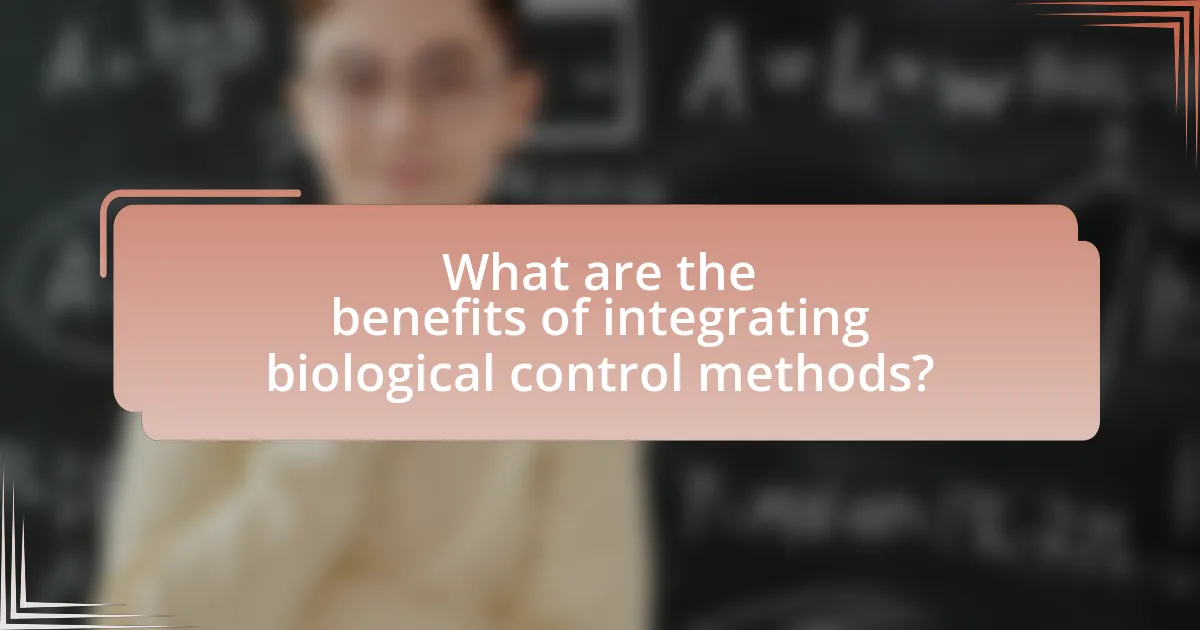
What are the benefits of integrating biological control methods?
Integrating biological control methods offers several benefits, including reduced reliance on chemical pesticides, enhanced ecosystem health, and improved pest management sustainability. By utilizing natural predators or parasites to control pest populations, farmers can minimize chemical inputs, which decreases the risk of pesticide resistance and environmental contamination. Studies have shown that biological control can lead to a more balanced ecosystem, promoting biodiversity and supporting beneficial organisms. Additionally, research indicates that integrated biological control strategies can result in long-term pest suppression, ultimately leading to more sustainable agricultural practices and improved crop yields.
How does integrating biological control enhance pest management effectiveness?
Integrating biological control enhances pest management effectiveness by utilizing natural predators, parasites, or pathogens to suppress pest populations. This method reduces reliance on chemical pesticides, leading to lower environmental impact and improved ecosystem health. For instance, studies have shown that the introduction of lady beetles can significantly decrease aphid populations in agricultural settings, demonstrating a successful application of biological control. Additionally, research published in the journal “Biological Control” indicates that integrated pest management strategies that include biological control can lead to a 30-50% reduction in pest-related crop damage compared to conventional methods.
What are the economic advantages of using biological control methods?
Biological control methods offer significant economic advantages by reducing the costs associated with chemical pesticides and enhancing crop yields. These methods often lead to lower input costs for farmers, as they rely on natural predators or parasites to manage pest populations, which can decrease the need for expensive chemical treatments. For instance, a study published in the journal “Ecological Economics” found that biological control can reduce pest management costs by up to 50% in certain agricultural systems. Additionally, the use of biological control can improve ecosystem health, leading to long-term sustainability and reduced economic risks associated with pest outbreaks.
How does biological control impact environmental sustainability?
Biological control positively impacts environmental sustainability by reducing reliance on chemical pesticides, which can harm non-target species and ecosystems. This method utilizes natural predators, parasites, or pathogens to manage pest populations, thereby promoting biodiversity and ecological balance. For instance, the introduction of the parasitoid wasp, Encarsia formosa, has effectively controlled whitefly populations in greenhouse settings without the adverse effects associated with synthetic chemicals. Studies indicate that biological control can lead to healthier ecosystems, as it supports the natural food web and reduces chemical runoff into water bodies, ultimately enhancing soil and water quality.
What challenges are associated with biological control integration?
Biological control integration faces several challenges, including the potential for non-target effects, the establishment of biological control agents, and the need for consistent monitoring and evaluation. Non-target effects occur when biological control agents impact species other than the intended pests, potentially disrupting local ecosystems. Establishment challenges arise when introduced agents fail to survive or reproduce in the new environment, limiting their effectiveness. Additionally, ongoing monitoring is essential to assess the long-term impacts and efficacy of biological control methods, which can be resource-intensive and complex. These challenges highlight the need for careful planning and management in the integration of biological control into sustainable pest management strategies.
What are the potential risks of using biological control agents?
The potential risks of using biological control agents include non-target effects, establishment of invasive species, and disruption of local ecosystems. Non-target effects occur when biological control agents harm beneficial organisms, leading to unintended ecological consequences. For example, the introduction of the cane toad in Australia resulted in significant declines in native species due to its predation and competition. Establishment of invasive species can happen when biological control agents reproduce and spread beyond their intended area, as seen with the introduction of the purple loosestrife beetle, which affected local plant communities. Disruption of local ecosystems can arise from altering predator-prey dynamics, potentially leading to population imbalances and loss of biodiversity. These risks highlight the need for thorough risk assessments before implementing biological control strategies.
How can practitioners overcome barriers to implementing biological control?
Practitioners can overcome barriers to implementing biological control by enhancing education and training programs focused on the benefits and methodologies of biological control. Research indicates that a lack of knowledge and understanding among practitioners is a significant barrier; therefore, targeted workshops and seminars can improve awareness and skills. For instance, a study published in the Journal of Pest Science found that training programs significantly increased the adoption rates of biological control methods among farmers. Additionally, fostering collaboration between researchers, extension services, and practitioners can facilitate the sharing of successful case studies and best practices, further encouraging the implementation of biological control strategies.
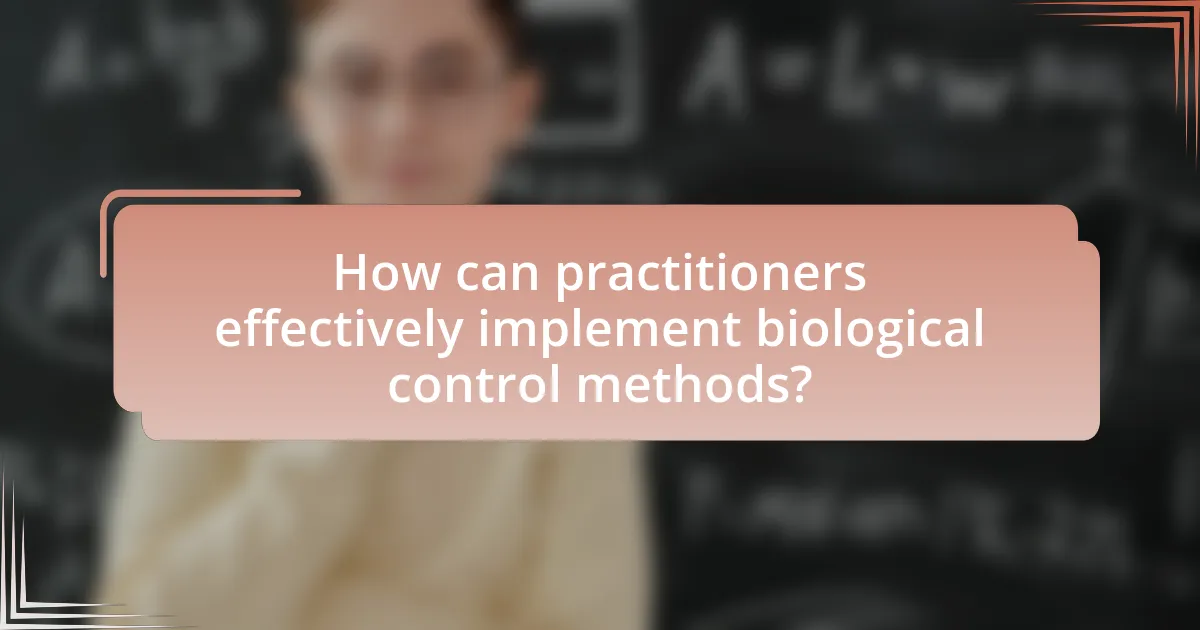
How can practitioners effectively implement biological control methods?
Practitioners can effectively implement biological control methods by selecting appropriate natural enemies, monitoring pest populations, and integrating these methods into existing pest management strategies. The selection of natural enemies, such as predators, parasitoids, or pathogens, should be based on the specific pest species and environmental conditions, ensuring compatibility and effectiveness. Monitoring pest populations allows practitioners to assess the impact of biological control agents and make necessary adjustments. Furthermore, integrating biological control with cultural, mechanical, and chemical methods enhances overall pest management efficacy, as evidenced by studies showing improved crop yields and reduced pesticide use when biological control is part of a holistic approach.
What steps should be taken to assess pest populations before implementation?
To assess pest populations before implementation, conduct a thorough survey of the area to identify pest species and their densities. This involves using traps, visual inspections, and sampling techniques to gather data on pest numbers and distribution. Accurate identification of pest species is crucial, as different species may require different management strategies. Additionally, monitoring environmental conditions such as temperature and humidity can provide insights into pest behavior and population dynamics. Research indicates that regular monitoring can lead to more effective pest management decisions, as demonstrated in studies showing that timely interventions based on population assessments can reduce pest damage by up to 50%.
How can practitioners select the appropriate biological control agents?
Practitioners can select appropriate biological control agents by assessing the target pest, understanding the ecological compatibility of potential agents, and evaluating the effectiveness of those agents in similar environments. The selection process begins with identifying the specific pest species and its life cycle, which helps in determining the most effective natural enemies. Research indicates that agents should be native or well-adapted to the local ecosystem to minimize risks of non-target effects and ensure successful establishment. For instance, studies have shown that using indigenous parasitoids can lead to better pest control outcomes compared to exotic species. Additionally, practitioners should consider the agent’s life history traits, such as reproduction rate and feeding behavior, to ensure they can effectively suppress the pest population.
What monitoring techniques are essential for evaluating effectiveness?
Essential monitoring techniques for evaluating effectiveness in sustainable pest management include population surveys, trap monitoring, and damage assessments. Population surveys involve regularly counting pest and beneficial insect populations to assess the impact of biological control methods. Trap monitoring utilizes various traps to capture and identify pest species, providing data on their abundance and distribution. Damage assessments evaluate the level of crop damage caused by pests, allowing for the measurement of control effectiveness. These techniques are validated by studies showing that consistent monitoring leads to improved decision-making and enhanced pest management outcomes.
What best practices should be followed for successful integration?
Successful integration of biological control methods in sustainable pest management requires a systematic approach that includes thorough planning, stakeholder involvement, and continuous monitoring. Effective integration begins with identifying the specific pest issues and selecting appropriate biological control agents that are compatible with the ecosystem. Research indicates that integrating multiple control strategies, such as combining biological methods with cultural practices, enhances overall effectiveness and sustainability. For instance, a study published in the journal “Biological Control” by Eilenberg et al. (2001) highlights that successful integration leads to reduced pesticide use and improved pest management outcomes. Additionally, ongoing evaluation and adaptation of strategies based on monitoring results ensure that the integration remains effective over time.
How can collaboration with local experts enhance biological control efforts?
Collaboration with local experts enhances biological control efforts by leveraging their in-depth knowledge of local ecosystems and pest dynamics. Local experts possess valuable insights into the specific environmental conditions, pest populations, and natural enemies present in the area, which can inform more effective and targeted biological control strategies. For instance, research has shown that integrating local ecological knowledge with scientific approaches can improve the success rates of biological control programs, as evidenced by case studies where local expertise led to the identification of native parasitoids that effectively managed pest populations. This collaboration not only increases the efficacy of biological control methods but also fosters community engagement and support for sustainable pest management practices.
What resources are available for ongoing education in biological control methods?
Ongoing education in biological control methods is supported by various resources including online courses, workshops, and academic journals. Institutions such as the University of California Cooperative Extension offer online training programs focused on integrated pest management, which includes biological control techniques. Additionally, the International Organization for Biological Control provides access to publications and resources that detail current research and practices in biological control. Academic journals like “Biological Control” publish peer-reviewed articles that contribute to the ongoing education of professionals in the field. These resources collectively enhance knowledge and application of biological control methods in sustainable pest management.
What practical tips can help in the successful application of biological control?
Successful application of biological control can be enhanced by selecting appropriate biocontrol agents that are well-suited to the target pest and local environmental conditions. For instance, using native parasitoids or predators can improve effectiveness due to their adaptation to local ecosystems. Additionally, monitoring pest populations and environmental factors regularly allows for timely interventions and adjustments in strategy. Implementing integrated pest management (IPM) practices, which combine biological control with cultural, mechanical, and chemical methods, further increases success rates. Research indicates that systems employing IPM can reduce pest populations significantly while minimizing chemical use, thus promoting sustainability.
